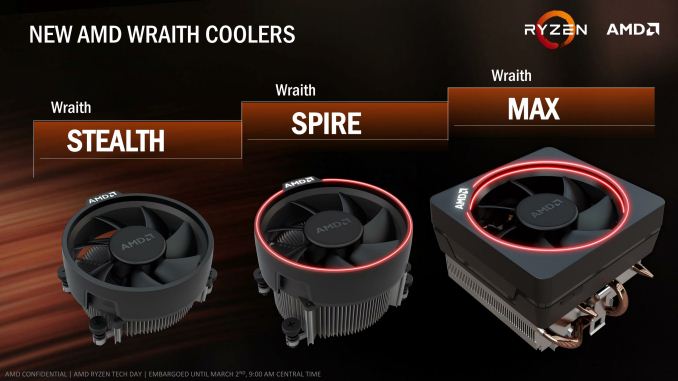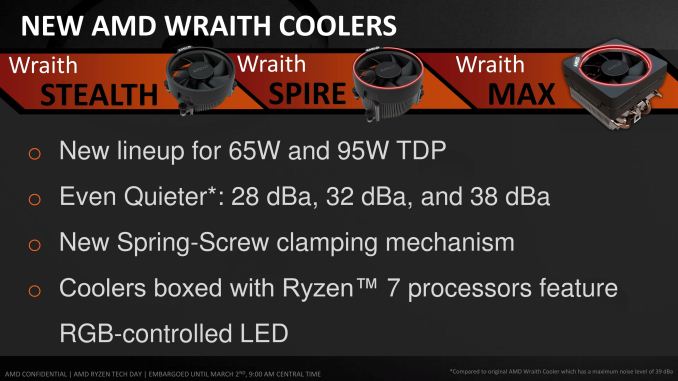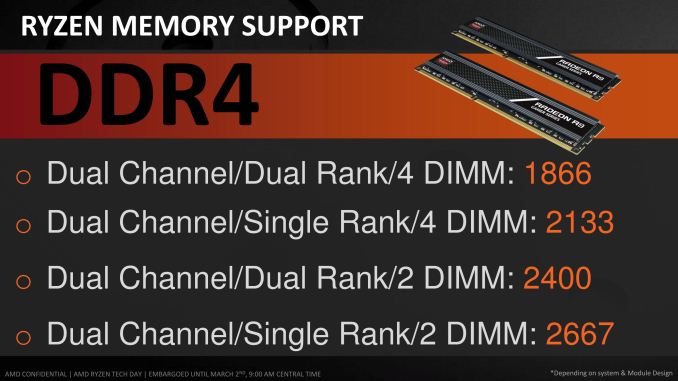The AMD Zen and Ryzen 7 Review: A Deep Dive on 1800X, 1700X and 1700
by Ian Cutress on March 2, 2017 9:00 AM ESTAMD Stock Coolers: Wraith v2
When AMD launched the Wraith cooler last year, bundled with the premium FX CPUs and highest performing APUs, it was a refreshing take on the eternal concept that the stock cooler isn’t worth the effort of using if you want any sustained performance. The Wraith, and the 125W/95W silent versions of the Wraith, were built like third party coolers, with a copper base/core, heatpipes, and a good fan. In our roundup of stock coolers, it was clear the Wraith held the top spot, easily matching $30 coolers in the market, except now it was being given away with the CPUs/APUs that needed that amount of cooling.
That was essentially a trial run for the Ryzen set of Wraith coolers. For the Ryzen 7 launch, AMD will have three models in play.
These are iterative designs on the original, with minor tweaks and aesthetic changes, but the concept is still the same – a 65W near silent design (Stealth), a 95W near silent design (Spire), and a 95W/125W premium model (Max). The 125W models come with an RGB light (which can be disabled), however AMD has stated that the premium model is currently destined for OEM and SI designs only. The other two will be bundled with the CPUs or potentially be available at retail. We have asked that we get the set in for review, to add to our Wraith numbers.
Memory Support
With every generation of CPUs, each one comes with a ‘maximum supported memory frequency’. This is typically given as a number, with the number aligning with the industry standard JEDEC sub-timings. Technically most processors will go above and beyond the memory frequency as the integrated memory controller supports a lot more; but the manufacturer only officially guarantees up to the maximum supported frequency on qualified memory kits.
The frequency, for consumer chips, is usually given as a single number no matter how many memory slots are populated. In reality when more memory modules are in play, it puts more strain on the memory controller so there is a higher potential for errors. This is why qualification is important – if the vendor has a guaranteed speed, any configuration for a qualified kit should work at that speed.
In the server market, a CPU manufacturer might list support a little differently – a supported frequency depending on how many memory modules are in play, and what type of modules. This arguably makes it very confusing when applied at a consumer level, but on a server level it is expected that OEMs can handle the varying degree of support.
For Ryzen, AMD is taking the latter approach. What we have is DDR4-2666 for the simplest configuration – one module per channel of single rank UDIMMs. This moves through to DDR4-1866 for the most strenuous configuration at two modules per channel with dual-rank UDIMMs. For our testing, we were running the memory at DDR4-2400, for lack of a fixed option, however we will have memory scaling numbers in due course. At present, ECC is not supported ECC is supported.













574 Comments
View All Comments
mapesdhs - Sunday, March 5, 2017 - link
Yet another example of manipulation which wouldn't be tolerated in other areas of commercial product. I keep coming across examples in the tech world where products are deliberately crippled, prices get hiked, etc., but because it's tech stuff, nobody cares. Media never mentions it.Last week I asked a seller site about why a particular 32GB 3200MHz DDR4 kit they had listed (awaiting an ETA) was so much cheaper than the official kits for Ryzen (same brand of RAM please note). Overnight, the seller site changed the ETA to next week but also increased the price by a whopping 80%, making it completely irrelevant. I've seen this happen three times with different products in the last 2 weeks.
Ian.
HomeworldFound - Sunday, March 5, 2017 - link
If they were pretty cheap then use your logic, placeholder prices happen. If they had no ETA the chances is that they had no prices. I don't see a shortage of decent DDR4 so it definitely isn't a supply and demand problem. Perhaps you need to talk to the manufacturer to get their guideline prices.HomeworldFound - Sunday, March 5, 2017 - link
Not really. If developers wanted to enhance AMD platforms, or it was actually worth it they'd have done it by now. It's now just an excuse to explain either underperformance or an inability to work with the industry.Notmyusualid - Tuesday, March 7, 2017 - link
@ sedraIt certainly should not be forgotten, that is for sure.
Rene23 - Monday, March 6, 2017 - link
yet people here mentioned multiple times "settled in 2009"; pretending it is not happening anymore, sick :-/GeoffreyA - Monday, March 6, 2017 - link
I kind of vaguely knew that benchmarks were often unfairly optimised for Intel CPUs; but I never knew this detailed information before, and from such a reputable source: Agner Fog. I know that he's an authority on CPU microarchitectures and things like that. Intel is evil. Even now with Ryzen, it seems the whole software ecosystem is somewhat suboptimal on it, because of software being tuned over the last decade for the Core microarchitecture. Yet, despite all that, Ryzen is still smashing Intel in many of the benchmarks.Outlander_04 - Monday, March 6, 2017 - link
Settled in 2009 .Not relevant to optimisation for Ryzen in any way
Rene23 - Monday, March 6, 2017 - link
settled in 2009 does not mean their current compiler and libraries are not doing it anymore, e.g. it could simply not run the best SSE/AVX code path disguised as simply not matching new AMD cpus properly.cocochanel - Saturday, March 4, 2017 - link
One thing that is not being mentioned by many is the increase in savings when you buy a CPU + mobo. Intel knows how to milk the consumer. On their 6-8 core flagships, a mobo with a top chipset will set you back 300-400 $ or even more. That's a lot for a mobo. Add the overpriced CPU. I expect AMD mobos to offer better value. Historically, they always did.On top of that, a VEGA GPU will probably be a better match for Ryzen than an Nvidia card, but I say probably and not certainly.
If I were to replace my aging gaming rig for Christmas, this would be my first choice.
mapesdhs - Sunday, March 5, 2017 - link
Bang goes the saving when one asks about a RAM kit awaiting an ETA and the seller hikes the price by 80% overnight (see my comment above).